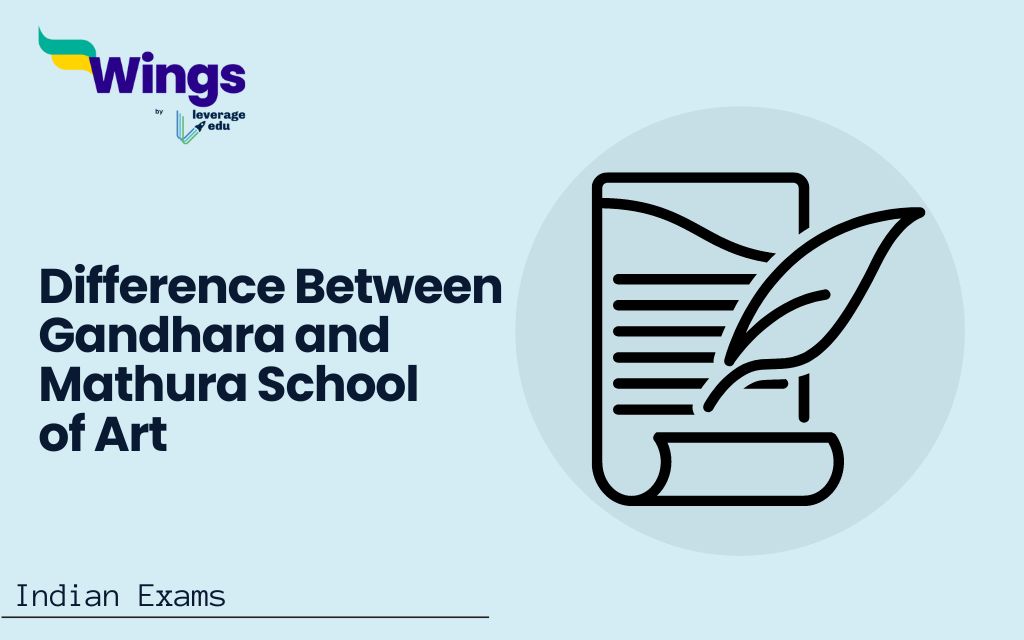Gandhara and Mathura, two prominent Indian art schools, differed greatly. Gandhara, influenced by Greco-Roman styles, depicted the Buddha realistically in stucco and schist, focusing on Buddhist themes. It belonged to the Gandhara region. In contrast, Mathura, rooted in Indian traditions, used red sandstone and granite to create symbolic figures across Hindu and Buddhist themes. Located in Mathura, India, it followed a broader religious scope. Understanding these stylistic, thematic, and geographic distinctions is important for the UPSC Civil Services Examination.
Contents
About the Gandhara School of Art
The Gandhara school of art was present in what is now Pakistan and Afghanistan, from roughly 100 BC to 500 AD. What made it unlique? A mix of influences!
- Greco-Roman and Persian art: Imagine Indian art with touches of Greek and Roman styles, like wavy hair and realistic figures.
- Buddhist focus: This school of art mainly depicted stories and figures important to Buddhism, like the Buddha himself and other holy beings.
- Material matters: Their favorite medium? Gandhara schist, a special type of gray-green stone.
About the Mathura School of Art
Imagine an art school in Mathura, India, that flourished around 2000 years ago. This is the Mathura School of Art, known for its unique style.
- Indian roots: Unlike some Indian art with Greco-Roman influences, Mathura art was purely Indian. Think curly hair and rounder figures for the Buddha and other holy beings.
- Local love: The artists loved using a special red sandstone found right there in Mathura for their sculptures and carvings.
- More than just Buddha: While the Mathura School did depict Buddhist figures, they also created art for Hindus and Jains, showcasing scenes from epic stories and even royalty.
- Serene style: Mathura art aimed for a sense of calmness and elegance. Their figures weren’t super realistic, but rather had a stylized beauty.
- Flat is where it’s at: Mathura artists preferred creating low reliefs or carvings on panels, instead of the more three-dimensionnal statues favored by the Gandhara School.
- Material matters: Their favorite medium? Gandhara schist, a special type of gray-green stone.
Difference Between Gandhara and Mathura School of Art
Here we have stated the difference between the gandhara and mathura school of art:
| Parameter | Gandhara School of Art | Mathura School of Art |
| Geographical Location | Pakistan and Afghanistan | Uttar Pradesh, India |
| Artistic Influence | Greco-Roman and Persian styles | Mix of Indian styles with some Greek influence |
| Sculpture Style | Detailed and dynamic figures | Serene and stylized figures |
| Subject Matter | Mainly Buddha’s life and Bodhisattvas | Buddhist, Hindu, and Jain themes |
| Materials Used | Gandhara schist (grey-green stone) | Local red sandstone |
| Portrayal of Buddha | Greco-Roman features | Indian features |
| Artistic Techniques | High relief and freestanding sculptures | Low relief and carved panels |
| Artistic Evolution | Became more Indian over time | Maintained a consistent Indian style throughout |
Similarities Between Gandhara and Mathura School of Art
Similarities between Gandhara and Mathura Art Schools typically includes:
- Both Loved Buddhism: Both schools created a lot of Buddhist art, showing the Buddha, holy helpers (Bodhisattvas), and stories from the religion.
- Similar Buddha Look: Even though their styles differed, they agreed on some details for the Buddha. He has a bump on his head (ushnisha – wisdom), a dot between his brows (urna – vision), and long earlobes.
- Same Time Period: They flourished around the same time (roughly 1st century BC to 3rd century CE).
- Relief Work Fans: Both schools used reliefs (carvings on flat surfaces) to show stories, often on religious buildings.
- Local Materials: They used what they had! Gandhara used gray stone, Mathura used red sandstone. But their techniques were similar.
- Realistic People: Both schools showed people in a realistic way, with details on clothes, bodies, and faces.
Must-Know Facts about Gandhara & Mathura Art
Gandhara Art (Afghanistan & NW India, 1st BC – 5th AD)
- Greek and Roman vibes: Influenced by trade and conquests, Gandhara art features a more realistic Buddha with flowing hair and a serene look.
- Material matters: Used grey stone at first, then switched to mud and plaster.
- Focus on Buddhism: Showed the Buddha, holy helpers (Bodhisattvas), and Buddhist stories.
- Unique blend: A cool example of foreign influences shaping Indian art, especially Buddhist statues.
Mathura Art (Mathura, India, 1st BC – 12th AD)
- Rooted in India: Mostly influenced by Indian religions (Hindu, Buddhist, Jain).
- Buddha with a twist: The Buddha here has a shaved head, stylized features, and sits in different hand gestures (mudras).
- Red sandstone specialist: Used a distinctive red stone for sculptures.
- Spiritual symbols: Emphasized spiritual meaning through a more stylized and idealized approach.
- Wider range of figures: Showcased not just the Buddha, but also Hindu gods and goddesses, and Jain figures.
- Indian art foundation: Laid the groundwork for future Indian art traditions, influencing other regions too.
Related Blogs
FAQs
Mathura art emphasizes naturalism, with softer features, while Gandhara art shows Hellenistic influence with more idealized, muscular figures.
Mathura Buddha is depicted standing, with more stylized features, while Sarnath Buddha is seated in a meditative posture, conveying calmness.
The Mathura School of Art focuses on depicting the life events and symbols associated with Buddha and Jain Tirthankaras.
Major schools include Mathura, Gandhara, Amaravati, and Gupta, each with distinct regional styles and influences in Buddhist iconography.
This was all about “Difference between Gandhara and Mathura School of Art”. For more such informative blogs, check out our UPSC Exams Section, or you can learn more about us by visiting our Indian exams page.
 One app for all your study abroad needs
One app for all your study abroad needs














